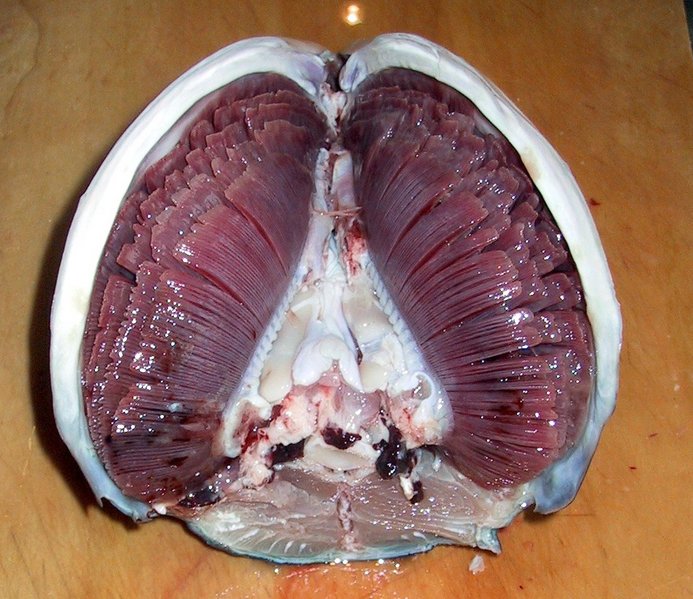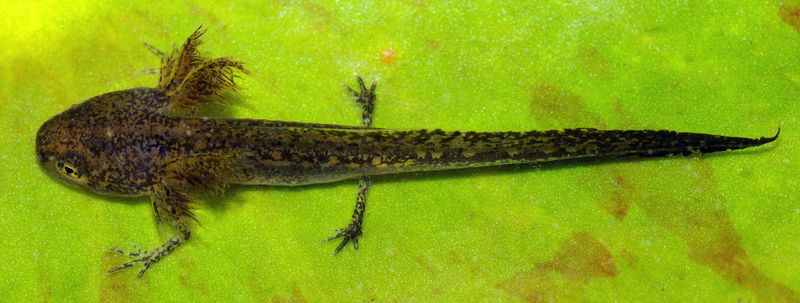Gill
 From Wikidoc - Reading time: 5 min
From Wikidoc - Reading time: 5 min
|
WikiDoc Resources for Gill |
|
Articles |
|---|
|
Media |
|
Evidence Based Medicine |
|
Clinical Trials |
|
Ongoing Trials on Gill at Clinical Trials.gov Clinical Trials on Gill at Google
|
|
Guidelines / Policies / Govt |
|
US National Guidelines Clearinghouse on Gill
|
|
Books |
|
News |
|
Commentary |
|
Definitions |
|
Patient Resources / Community |
|
Directions to Hospitals Treating Gill Risk calculators and risk factors for Gill
|
|
Healthcare Provider Resources |
|
Continuing Medical Education (CME) |
|
International |
|
|
|
Business |
|
Experimental / Informatics |
A gill is a respiration organ that functions for the extraction of oxygen from water and the excretion of carbon dioxide. Unlike many small aquatic animals, which can absorb oxygen through the entire surface of their bodies, more complex aquatic organisms have gills specially formed to present an adequate surface area to the external environment. Gills are usually thin plates of tissue, branches, or slender tufted processes and, with the exception of some aquatic insects, they contain blood or coelomic fluid, which exchanges gases through their thin walls. Oxygen is carried by the blood to other parts of the body. Carbon dioxide passes from the blood through the thin gill tissue into the water. Gills or gill-like organs, located in different parts of the body, are found in various groups of animalia. These include mollusks, crustaceans, insects, fish, and amphibians.
Invertebrate gills[edit | edit source]
Respiration in Echinodermata (includes starfish and sea urchins) is done through a very primitive version of gills called papulli, thin protuberances on the surface of the body containing diverticula of the water vascular system. In crustaceans, mollusks and some insects, they are tufted or plate-like structures at the surface of the body in which blood circulates.
The gills of other insects are of the tracheal kind and also include both thin plates and tufted structures, and, in the larval dragon fly, the wall of the caudal end of the alimentary tract (rectum) is richly supplied with tracheae as a rectal gill. Water pumped into and out of the rectum provide oxygen to the closed tracheae. In the aquatic insects, a unique type of respiratory organ is used, the tracheal gill, which contains air tubes. The oxygen in these tubes is renewed through the gills.
Physical gills[edit | edit source]
Physical gills are a type of structural adaptation common among some types of aquatic insects, in which atmospheric oxygen is held within an area into which the spiracles open. The structure (often called a plastron) typically consists of dense patches of hydrophobic setae on the body, which prevent water entry into the spiracles. The physical properties of the interface between the trapped air bubble and the surrounding water function so as to accomplish gas exchange through the spriacles, almost as if the insect were in atmospheric air. Carbon dioxide diffuses out into the surrounding water due to its high solubility, while oxygen diffuses into the bubble, as the concentration within the bubble has been reduced by respiration, and nitrogen also diffuses out as its tension has been increased. Oxygen diffuses into the bubble at a higher rate than Nitrogen diffuses out. However, water surrounding the insect can become oxygen-depleted if there is no water movement, so many aquatic insects in still water actively direct a flow of water over their bodies.
The physical gill mechanism allows aquatic insects with plastrons to remain constantly submerged. Examples include many beetles in the family Elmidae, aquatic weevils, and true bugs in the family Aphelocheiridae.
Vertebrate gills[edit | edit source]

Gills of vertebrates are developed in the walls of the pharynx along a series of gill slits opening to the exterior. In fish, the gills are located on both sides of the pharynx. Gills are made of filaments which help increase surface area for oxygen exchange. In bony fish, the gills are covered by a bony cover called an operculum. When a fish breathes, it opens its mouth at regular times and draws in a mouthful of water. It then draws the sides of its throat together, forcing the water through the gill openings. The water passes over the gills on the outside. Valves inside the mouth keep the water from escaping through the mouth again. The operculum can be very important in adjusting the pressure of water inside of the pharynx to allow proper ventilation of the gills. Lampreys and sharks lack an operculum, they have multiple gill openings. Also, they must use different methods to force water over the gills. In sharks and rays, this ventilation of the gills is achieved either by the use of spiracles or ram ventilation (ventilation by constantly swimming).
In most species, a countercurrent exchange system is employed to enhance the diffusion of substances in and out of the gill, with blood and water flowing in opposite directions to each other. Water taken into the mouth passes out of the slits, bathing the gills as it passes.
Some fish utilize the gills for the excretion of electrolytes. Gills' large surface area tends to create a problem for fish seeking to regulate the osmolarity of their internal fluids. Saltwater is less dilute than these internal fluids; as a consequence, saltwater fish lose large quantities of water osmotically through their gills. To regain the water, they drink large amounts of seawater and excrete the salt. Freshwater is more dilute than the internal fluids of fish, however, so freshwater fish gain water osmotically through their gills.
The gill slits of fish are believed to be the evolutionary ancestors of the tonsils, thymus gland, and Eustachian tubes, as well as many other structures derived from the embryonic branchial pouches. In some amphibians, the gills occupy the same position on the body but protrude as external tufts.

Branchia[edit | edit source]
Branchia (pl. branchiæ) is the name given by the Ancient Greek naturalists to the gills of fish. Galen observed that they are full of little foramina, big enough to admit gasses, but too fine to give passage to water. Pliny the Elder held that fish respired by their gills, but observed that Aristotle was of another opinion.[1]
The word branchia comes from the Greek Template:Polytonic, "gills", plural of Template:Polytonic (in singular, meaning a fin).[2]
References[edit | edit source]
- ↑ Template:1728
- ↑ "Branchia". Oxford English Dictionary. Oxford University Press. 2nd Ed. 1989.
See also[edit | edit source]
- Aquatic respiration
- Book lung
- Lung
 KSF
KSF